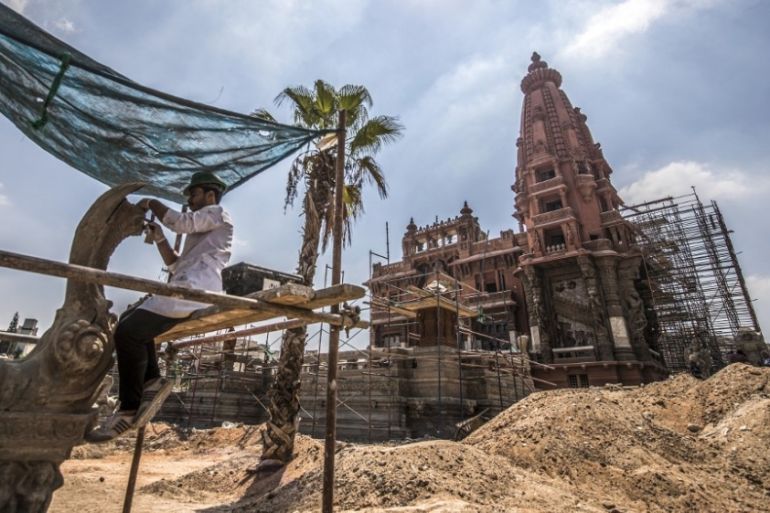Egypt: Criticism of Baron Empain Palace restoration ‘fake news’
The Baron Empain Palace was built in 1907 by Belgian industrialist Edouard Empain and is a Cairo landmark.

The Egyptian minister of antiquities has denounced criticism of restoration works at one of Cairo’s landmark buildings, the Baron Empain Palace.
The building was built between 1907 and 1911 by Belgian industrialist Edouard Empain who also masterminded the construction of the Paris Metro. It is being restored after falling into disrepair over the past decades.
Keep reading
list of 4 itemsInside the pressures facing Quebec’s billion-dollar maple syrup industry
‘Accepted in both [worlds]’: Indonesia’s Chinese Muslims prepare for Eid
Photos: Mexico, US, Canada mesmerised by rare total solar eclipse
Set among lush gardens in the neighbourhood of Heliopolis, which was founded by Empain, the palace is a familiar sight with its rose-coloured walls and distinctive design inspired by the temples of Angkor Wat in Cambodia and Orissa in India.
The main tower in the palace is said to be built on a rotating base to follow the movement of the sun and to allow a 360-degree view of Empain’s brainchild, the desert city named after the ancient Egyptian Heliopolis, “City of the Sun”.
Heliopolis was a new, desert suburb at the beginning of the 20th century and soon became an upscale neighbourhood home to politicians, celebrities, famous athletes and wealthy families.
Losing its character
The current restoration has come under scrutiny as critics say the building, nicknamed the Hindu Palace by many, is losing its distinctive character.
One Twitter user asked: “Who is the fool behind the restoration of Egypt’s palaces? Our heritage is being systematically destroyed.”
A Facebook page called Egyptian Historians chided officials for the “warped” restoration.
“Be honest with yourselves and admit that you ruined it… you are literally demolishing our monuments,” a post on the group’s page said.
Antiquities Minister Khaled El-Enany dismissed online criticism as “fake news”, AFP news agency reported.
“I didn’t hear one word of truth in all these social media comments,” he said in a statement.
A concern is the use of white marble on the facade during the restoration, which led some to mourn the loss of the distinctive rose-coloured facade.
Authorities in charge of the restoration have said that the original colours of the building are, in fact, being respected and that years of dust had given the “rose” tint people were accustomed to.
General Hisham Samir, who heads up the ministry’s engineering branch, said the colours were “correct and are backed up by historical sources”.
The restoration, which started in 2017 and is supposed to be completed by the end of this year, is being done in conjunction with the Belgian government at a cost of approximately $6m.
The restored palace is scheduled to officially open again next year.
Egypt’s multitude of historical monuments and buildings are a major draw for tourists, though the country has often faced accusations of neglecting these sites.
The government has recently launched various restoration projects to stimulate tourism, a key sector that has suffered in recent years due to political insecurity and sporadic attacks.